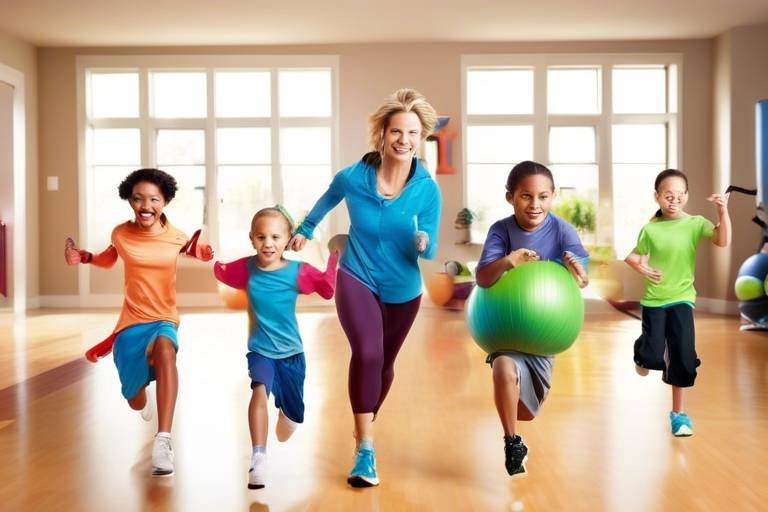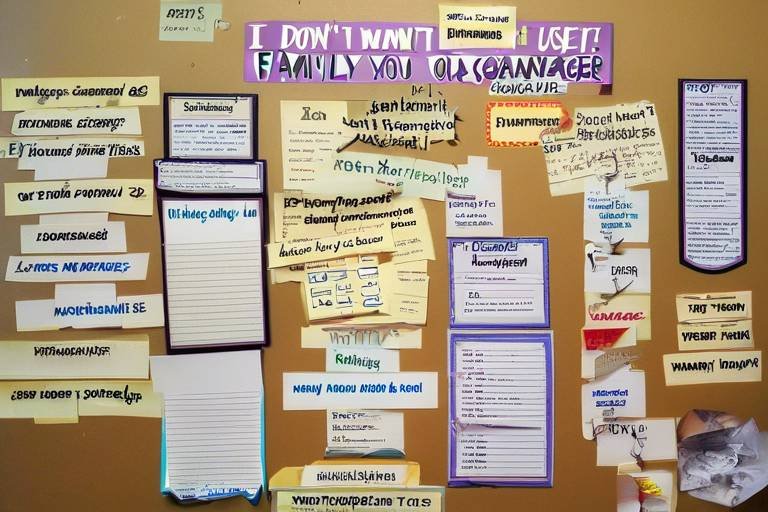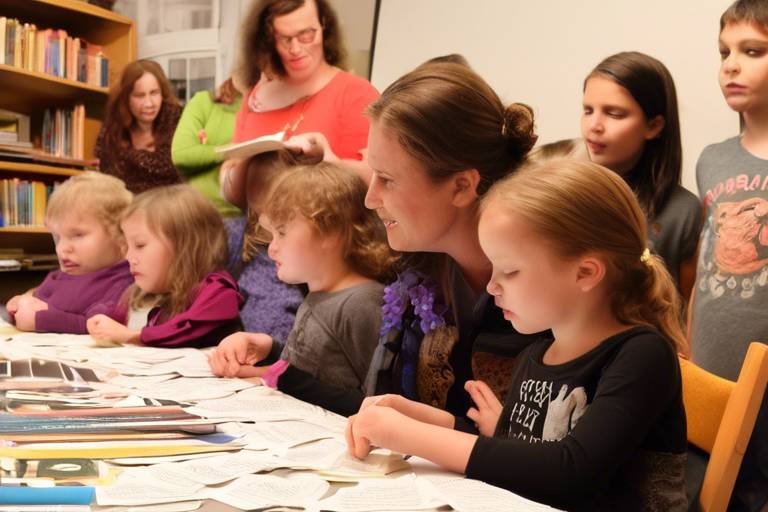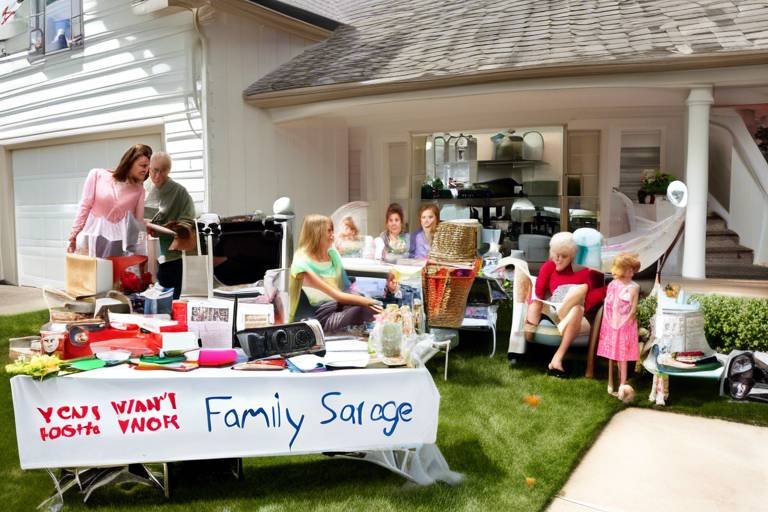Staying Active: Indoor Family Fitness Fun
In today's fast-paced world, it's easy to let our busy schedules and the ever-changing weather dictate our activity levels. But what if I told you that staying active as a family doesn't have to be a challenge? Indoor family fitness fun can be an exciting and rewarding way to bond, stay healthy, and create lasting memories, all from the comfort of your own home. Whether it's a rainy day or you simply want to avoid the hustle and bustle of a gym, there are countless creative ways to keep the family moving and grooving indoors.
Imagine transforming your living room into a vibrant dance floor, or rolling out yoga mats in the kitchen while the aroma of dinner fills the air. The possibilities are endless! By engaging in indoor activities, families can not only improve their physical health but also strengthen their emotional connections. After all, working out together is a fantastic way to share laughter, encouragement, and a few friendly competitions that can make the experience even more enjoyable.
So, are you ready to discover how to make fitness a fun family affair? Let’s dive into some exciting indoor exercise ideas that will keep everyone active, regardless of age or fitness level. Because when it comes to family fitness, the key is to find activities that everyone loves, ensuring that the journey to health is as enjoyable as the destination!
Understanding the benefits of family fitness is crucial. It not only promotes physical health but also strengthens family bonds and encourages a healthy lifestyle among all members, setting a positive example for children. When families engage in fitness activities together, they foster a sense of teamwork and support that can carry over into other areas of life, like academics or personal growth.
Moreover, making fitness a family priority helps instill healthy habits in children from a young age. They learn to value physical activity and understand its importance in maintaining a balanced lifestyle. By participating in fitness routines as a family, you’re not just improving your health; you’re also creating a legacy of wellness that can last for generations. Isn’t that a powerful reason to get moving together?
There are numerous indoor exercises suitable for families. From yoga to dance parties, these activities can be enjoyable and effective, ensuring everyone stays engaged while working towards fitness goals together. Here are a few ideas to get you started:
- Yoga: A calming activity that promotes flexibility and mindfulness.
- Dance Workouts: Fun and energetic, perfect for letting loose and enjoying music.
- Obstacle Courses: Use household items to create a challenging course that everyone can navigate.
- Fitness Challenges: Create friendly competitions, like who can do the most jumping jacks or hold a plank the longest.
By mixing up these activities, your family can avoid the monotony that often comes with traditional workouts. Plus, the laughter and joy that come from these shared experiences will make your fitness journey feel less like a chore and more like an adventure!
Yoga is a versatile activity that can be adapted for all ages. It promotes flexibility, balance, and mindfulness, making it an excellent choice for families looking to unwind and connect through movement. Picture this: a serene space in your home where everyone gathers, mats laid out, and soft music playing in the background. It’s a perfect way to escape the chaos of daily life!
Hosting family yoga sessions can foster a calm atmosphere while encouraging physical activity. Practicing together enhances communication and creates a shared experience that everyone can enjoy and benefit from. Whether you follow along with a video or create your own poses, the key is to have fun and support one another. Remember, it’s not about perfection; it’s about connection!
Incorporating mindfulness into yoga practice helps families manage stress and improve mental well-being. This focus on the present moment can enhance emotional connections and promote a peaceful home environment. By encouraging open discussions about feelings and experiences during practice, families can strengthen their bonds and foster an atmosphere of trust and love.
Dance workouts are an entertaining way to get the heart pumping. Families can enjoy various styles, from Zumba to hip-hop, making exercise feel like a fun party rather than a chore. Just crank up the music and let loose! You might be surprised at how much energy everyone brings to the floor, and it’s a fantastic way to express creativity while breaking a sweat.
Establishing a regular fitness routine can help families stay committed to their health goals. By scheduling activities together, family members can hold each other accountable and celebrate progress along the way. Think of it as a team effort, where everyone plays a role in supporting one another. You’re not just working out; you’re building a healthier lifestyle together!
Setting achievable fitness goals ensures that everyone remains motivated. Families should consider individual abilities and preferences to create a plan that is both challenging and enjoyable for all members. For instance, if one family member loves dancing while another prefers yoga, find a balance that incorporates both activities. This way, everyone feels included, and the journey becomes more rewarding.
Tracking fitness progress as a family can enhance motivation. Utilizing charts or apps to record achievements fosters a sense of accomplishment and encourages friendly competition, making fitness more engaging for everyone. Consider creating a family fitness board where everyone can post their goals and achievements. This visual representation of progress can serve as a great motivator!
1. What are some easy indoor activities for families?
There are many options! You can try yoga, dance workouts, indoor obstacle courses, or even fun fitness challenges like relay races using household items.
2. How can I get my kids interested in fitness?
Make it fun! Use music, games, and creative challenges to engage them. The key is to focus on enjoyment rather than competition.
3. How often should we exercise as a family?
Aim for at least 150 minutes of moderate aerobic activity each week, which can be broken down into shorter sessions that fit your family’s schedule.
4. What if we have different fitness levels?
That’s perfectly fine! Choose activities that can be modified for different skill levels, ensuring everyone can participate and feel included.

Importance of Family Fitness
Understanding the benefits of family fitness is crucial for creating a healthy home environment. When families engage in physical activities together, they not only promote physical health but also strengthen the bonds that tie them together. Imagine the laughter and joy that fills the room when everyone participates in a fun workout session! It’s like a recipe for happiness that combines fitness with quality time. This shared experience sets a positive example for children, teaching them the importance of staying active and leading a healthy lifestyle.
Moreover, family fitness activities are a fantastic way to combat the growing trend of sedentary behavior, especially in today’s digital age. With screens everywhere, it’s easy for family members to lose track of their physical activity. By prioritizing fitness as a family, you create a culture where movement is celebrated. Not only does this help in maintaining a healthy weight, but it also enhances overall well-being. Physical activity releases endorphins, which are natural mood lifters. So, when families work out together, they contribute to each other's mental health too!
Additionally, engaging in fitness as a family can lead to better communication and teamwork. As you sweat it out together, you learn to support one another, celebrate each other's victories, and encourage each other during challenges. This can be as simple as cheering on a sibling during a challenging exercise or collaborating on a family fitness goal. The emotional connections that develop during these activities can lead to stronger relationships outside the gym, fostering a sense of unity and teamwork that transcends fitness.
To highlight the significance of family fitness, here’s a quick overview of its key benefits:
| Benefit | Description |
|---|---|
| Physical Health | Improves cardiovascular health, strengthens muscles, and aids in weight management. |
| Mental Well-being | Boosts mood through endorphin release and reduces stress levels. |
| Family Bonding | Enhances relationships through shared experiences and teamwork. |
| Healthy Habits | Instills lifelong habits of physical activity in children. |
In conclusion, family fitness is more than just a way to stay in shape; it’s a holistic approach to nurturing a happy, healthy family. By making fitness a priority, families can create a legacy of health that will benefit generations to come. So, why not start today? Lace up those sneakers, gather your loved ones, and embark on this exciting journey together!

Indoor Exercise Ideas
When it comes to staying active indoors, the possibilities are as vast as your imagination! Whether you're facing a rainy day or just want to escape the heat, there are countless that can keep the whole family engaged and moving. Picture this: instead of lounging on the couch, you're all together in the living room, laughing and sweating as you dance, stretch, and play. Sounds fun, right? Let's dive into some exciting activities that will not only get your heart pumping but also create lasting memories.
One fantastic option is to turn your living room into a yoga studio. Grab some mats, dim the lights, and play some calming music. Yoga is not just about bending and stretching; it’s a journey of self-discovery that can help you and your family connect on a deeper level. You can follow along with online classes or even create your own flow. Imagine the joy of seeing your kids master a downward dog or a tree pose! Plus, yoga is adaptable for all ages, making it a perfect choice for family fitness.
Another great way to keep the energy high is by hosting a dancing party. Crank up your favorite tunes and let loose! Whether it’s Zumba, hip-hop, or even a little bit of salsa, dancing is an exhilarating way to exercise without it feeling like a chore. You can even turn it into a mini talent show where each family member gets to showcase their best moves. Not only will you burn calories, but you’ll also create a vibrant atmosphere filled with laughter and joy.
If you’re looking for something a bit more structured, consider setting up a family fitness circuit. You can create different stations around the house, each focusing on a specific exercise, such as push-ups, sit-ups, or jumping jacks. Set a timer for each station, and then rotate. This not only keeps everyone active but also introduces a bit of friendly competition. You can even keep track of who completes the most rounds or performs the most reps, adding an exciting twist to your fitness routine.
For those who love a challenge, why not try a virtual workout class? Many platforms offer live classes that cater to various fitness levels. You can all follow along together, whether it’s kickboxing, Pilates, or a family-friendly boot camp. This can be a great way to try something new and keep the workouts fresh and exciting. Plus, it’s a fantastic opportunity to bond over shared struggles and achievements.
Lastly, don’t underestimate the power of playing games. Turn fitness into fun by incorporating active video games that require movement, or play classic games like charades and freeze dance. These activities can keep everyone moving while also sparking creativity and laughter. You’ll be surprised at how much exercise you can sneak in while having a blast!
With these indoor exercise ideas, you can transform your home into a hub of activity and fun. The key is to keep it light-hearted and enjoyable. Remember, the goal is not just to stay fit but to strengthen family bonds and create unforgettable moments together. So, what are you waiting for? Get moving and let the fun begin!

Yoga for All Ages
Yoga is a truly versatile activity that caters to individuals of all ages, making it an ideal choice for families looking to bond while staying active. Whether you have toddlers who are just discovering their bodies or grandparents seeking gentle movement, yoga can be tailored to meet everyone's needs. Imagine a space where young and old alike can stretch, breathe, and laugh together—this is the magic of family yoga. The beauty of yoga lies in its adaptability; it can be as gentle or as challenging as you want it to be.
One of the most significant benefits of practicing yoga as a family is the promotion of flexibility, balance, and mindfulness. These elements are not just physical; they extend into emotional and mental realms too. For instance, while a child learns to hold a pose, they are also learning patience and focus. On the other hand, parents can find a moment of calm amidst their busy lives, fostering a peaceful home environment.
Moreover, yoga sessions can be a fantastic opportunity for families to engage in meaningful conversations and share experiences. You might start with a simple pose like the Tree Pose, where everyone stands tall and tries to maintain balance. As you practice, you can share stories about times when you felt strong or wobbly in life, creating a deeper connection.
To make family yoga sessions even more enjoyable, consider incorporating fun themes or challenges. For example, you could have a "Yoga Around the World" day where each family member chooses a pose from a different culture. This not only adds an educational element but also keeps everyone excited and engaged.
In conclusion, yoga for all ages is not just about physical exercise; it’s a holistic approach to family bonding and well-being. The laughter, shared moments, and collective achievements during these sessions can create lasting memories that strengthen family ties. So why not roll out those mats, turn on some calming music, and embark on this beautiful journey together?

Family Yoga Sessions
Family yoga sessions are a fantastic way to blend fitness with quality time. Imagine gathering your loved ones in a cozy corner of your living room, rolling out those colorful yoga mats, and transforming your space into a serene sanctuary. It’s not just about stretching and poses; it’s about creating a shared experience that enhances communication and strengthens bonds. When you practice yoga together, you’re not only improving your physical health but also nurturing emotional connections.
To kick off a family yoga session, it’s essential to set the right mood. Dim the lights, play some soothing music, and maybe even light a few candles. It’s all about creating an atmosphere that invites relaxation and focus. You might start with simple poses that everyone can do, such as Child's Pose, Downward Dog, and Tree Pose. These poses are not only easy to learn but also help develop balance and strength.
As you flow through the session, encourage each family member to express themselves. Perhaps one of the kids wants to add a silly dance move between poses, or maybe someone feels like sharing a funny story. This playful interaction can turn a standard yoga session into a memorable family bonding experience. It's about finding joy in movement and being present with one another.
Additionally, consider incorporating some fun challenges during your yoga sessions. For instance, you could have a “Pose of the Day” where each family member takes turns demonstrating a pose, and everyone else tries to mimic it. Not only does this add a layer of fun, but it also encourages creativity and laughter. You could even reward the most creative pose with a small prize, like picking the next family movie night film!
Incorporating mindfulness into these sessions can also be beneficial. After a series of poses, take a few moments to sit in silence and focus on your breathing. This practice helps everyone to unwind and reflect. You might ask each family member to share one thing they are grateful for that day, fostering a spirit of appreciation and positivity.
Ultimately, family yoga sessions are about more than just physical exercise; they are an opportunity to connect deeply with one another. Whether it’s through shared laughter, supportive encouragement, or simply enjoying the moment together, these sessions can create lasting memories that resonate far beyond the yoga mat. So, why not roll out those mats and embark on a journey of wellness and connection together?
- What age is appropriate for children to start yoga? Most children can begin practicing yoga as early as 3 years old, but it's essential to keep the sessions fun and engaging for them.
- How long should a family yoga session last? A 20-30 minute session is typically ideal for families, especially with younger children, to keep their attention and enthusiasm high.
- Do we need special equipment for family yoga? While yoga mats are helpful, they are not mandatory. You can use towels or even do yoga on a carpeted surface.
- Can we practice yoga without a teacher? Absolutely! There are plenty of online resources and videos that can guide you through family-friendly yoga sessions.

Benefits of Mindfulness in Yoga
Practicing mindfulness during yoga can transform your family’s fitness journey into a holistic experience that nurtures both the body and the mind. When families engage in mindful yoga, they not only stretch their muscles but also cultivate a deeper connection with each other and themselves. This practice encourages awareness of the present moment, allowing individuals to let go of distractions and stressors that often invade our busy lives.
One of the most significant benefits of incorporating mindfulness into yoga is the enhancement of mental well-being. As families flow through poses together, they learn to focus on their breath and movements, which can significantly reduce anxiety and promote relaxation. Imagine the feeling of a warm hug after a long day; that’s what mindfulness can do for your mind during yoga. It creates a safe space where everyone can express themselves freely, fostering emotional connections that strengthen family bonds.
Moreover, mindfulness in yoga encourages a sense of gratitude and appreciation for one’s body. As family members learn to listen to their bodies, they become more aware of their physical capabilities and limitations, which can lead to a healthier body image. This awareness is crucial, especially for children, as it sets a positive example for how to treat their bodies with respect and love.
Here are some additional benefits of practicing mindfulness in yoga as a family:
- Improved Focus: Mindfulness enhances concentration, making it easier for family members to engage in activities together.
- Stress Reduction: Regular practice can significantly lower stress levels, creating a more peaceful home environment.
- Enhanced Communication: Practicing together can improve how family members communicate, fostering a supportive atmosphere.
Incorporating mindfulness into your family yoga sessions can also lead to improved emotional regulation. Children and adults alike learn to recognize their feelings and respond to them in a healthier manner. This skill can be invaluable in navigating the ups and downs of family life. Just as a tree bends with the wind, families that practice mindfulness can adapt to challenges with grace and resilience.
In summary, the benefits of mindfulness in yoga extend far beyond the mat. They create a foundation for a healthier, happier family life, where each member feels valued and connected. So, next time you roll out your yoga mats, remember that you’re not just exercising; you’re building a stronger family unit, one mindful breath at a time.
Q: How often should we practice yoga as a family?
A: Aim for at least once a week to build a routine, but feel free to practice more often if it fits your schedule!
Q: Can children participate in yoga?
A: Absolutely! Yoga is adaptable for all ages, and many poses can be modified to suit children’s needs.
Q: What if we don’t have space for yoga?
A: You can practice yoga in small spaces; just ensure that everyone has enough room to stretch their arms and legs comfortably.

Fun Dance Workouts
When it comes to family fitness, are like the cherry on top of a delicious sundae! Imagine the living room transformed into a vibrant dance floor, where everyone is moving, grooving, and having a blast. Dance workouts are not just about breaking a sweat; they are about creating joyful memories that last a lifetime. Whether you’re busting out some Zumba moves or getting down with hip-hop, the rhythm of the music can lift spirits and energize the entire family.
One of the best things about dance workouts is their versatility. You can tailor them to fit any age group or skill level. From toddlers who just want to wiggle to parents who might want to show off their old dance moves, everyone can join in the fun. Plus, there's no need for fancy equipment—just your favorite tunes and some space to move around!
To get started, consider these popular dance styles that can easily be done at home:
- Zumba: This high-energy dance workout combines Latin and international music with dance moves, making it a fantastic way to get your heart pumping!
- Hip-Hop: With its catchy beats and stylish moves, hip-hop dance can be a great way for kids and adults alike to express themselves.
- Just Dance Video Games: If your family enjoys gaming, try out dance video games that encourage everyone to follow along with the on-screen choreography.
Incorporating dance into your family fitness routine can be as simple as setting aside a specific time each week for a dance party. You can even take turns choosing the music, allowing each family member to share their favorite songs. This not only keeps things fresh but also helps everyone discover new genres and artists!
Moreover, dance workouts offer a plethora of benefits beyond just physical fitness. They can enhance coordination, boost confidence, and even improve mood due to the release of endorphins during exercise. Plus, dancing together fosters teamwork and communication, making it a perfect bonding activity for families.
So, why not put on your favorite playlist tonight and turn your living room into a dance studio? You might just find that the laughter and joy of moving together becomes one of your family’s favorite fitness traditions!
Q: Do I need any special equipment for dance workouts?
A: No special equipment is needed! All you need is some space to move and your favorite music.
Q: Can dance workouts be suitable for all ages?
A: Absolutely! Dance workouts can be adapted for all ages, making them a great choice for family fitness.
Q: How often should we do dance workouts as a family?
A: Aim for at least once a week, but feel free to dance more often if everyone is enjoying it!
Q: What if someone in the family is shy about dancing?
A: Encourage them to join in at their own pace. They can start by just moving to the music or even dancing in front of a mirror until they feel more comfortable.

Creating a Family Fitness Routine
Establishing a regular fitness routine is like setting the foundation for a strong house; it provides stability and ensures that everyone in the family stays committed to their health goals. When you make fitness a family affair, not only do you get to spend quality time together, but you also create an environment where healthy habits can thrive. Imagine a scenario where your family gathers around every week, excited about the upcoming activities, holding each other accountable, and celebrating progress. Sounds great, right? Well, it’s entirely possible!
First things first, it’s essential to schedule activities that fit into everyone’s busy lives. You might want to set aside specific days of the week for family workouts. By doing this, you create a sense of routine, making it easier for everyone to prioritize fitness. Whether it’s a Saturday morning yoga session or a Wednesday evening dance party, having these scheduled times can help everyone remember to show up and participate.
When planning your routine, consider individual preferences and abilities. Just like a well-tuned orchestra, each family member plays a unique role, and it’s crucial to harmonize those differences. For instance, some might love high-energy activities like Zumba, while others might prefer a calming yoga session. By incorporating a variety of exercises, you can keep the routine fresh and engaging. You could even create a family fitness calendar that highlights the activities for each week, ensuring everyone knows what to expect.
Another key aspect of a successful family fitness routine is setting realistic goals. Goals should be specific, measurable, achievable, relevant, and time-bound (SMART). For example, rather than saying, “We want to get fit,” try something like, “We will complete a 30-minute workout together three times a week for the next month.” This gives everyone something tangible to work towards and fosters a sense of accomplishment when those goals are met.
To make things even more exciting, consider tracking your progress together. You can use simple charts or even fitness apps to log workouts and achievements. This not only provides a visual representation of your efforts but also encourages friendly competition. Who can complete the most workouts in a month? Who can hold a plank the longest? These challenges can add an element of fun and motivation to your fitness journey.
Ultimately, the goal of creating a family fitness routine is to cultivate a healthy lifestyle that everyone enjoys. It’s about more than just physical fitness; it’s about building connections, sharing experiences, and fostering a positive mindset towards health. So, gather your family, brainstorm activities, and get moving together. You might just find that the journey towards fitness becomes one of the most cherished family traditions you create!
- How can we stay motivated as a family? Regularly set new goals and celebrate achievements together. Keep the activities fun and varied to maintain enthusiasm.
- What if someone doesn’t enjoy a specific activity? Encourage open communication about preferences. Adjust the routine to include activities that everyone enjoys.
- How often should we work out together? Aim for at least three times a week, but adjust based on your family’s schedule and energy levels.
- Can we include outdoor activities in our routine? Absolutely! Incorporate outdoor fun like hiking or biking whenever possible to mix things up.

Setting Realistic Goals
Setting realistic goals is essential for maintaining motivation and ensuring that every family member feels included in the fitness journey. It's like planning a road trip; if you don’t know your destination, how can you enjoy the ride? By defining clear, achievable objectives, families can create a roadmap that guides them toward their health and fitness aspirations. Start by discussing what everyone wants to achieve—whether it's losing weight, building strength, or simply staying active. This conversation not only promotes inclusion but also helps each member feel valued and heard.
When setting these goals, it's crucial to consider the varying abilities and preferences of each family member. For instance, while one child might love running, another might prefer a quiet yoga session. Therefore, establishing a blend of different activities can cater to everyone's interests. A useful approach is to categorize goals into short-term and long-term objectives. Short-term goals might include completing a family workout three times a week, while long-term goals could involve participating in a local fun run or a charity walk.
To make the goal-setting process even more engaging, families can create a visual progress chart. This could be a simple poster board where each member adds stickers for every workout completed or a digital app that tracks achievements. Not only does this foster a sense of achievement, but it also encourages a little friendly competition. After all, who doesn’t love a bit of playful rivalry? Remember, the key is to celebrate every milestone, no matter how small. This can be as simple as a family movie night or a special treat after reaching a goal, reinforcing the idea that hard work pays off.
In addition, here are a few tips for setting realistic fitness goals:
- Be Specific: Instead of saying, "I want to be fit," specify what that means. For example, "I want to do 20 push-ups without stopping."
- Make it Measurable: Use numbers to track progress. This could be distance run, time spent exercising, or the number of workouts completed each week.
- Keep it Attainable: Set goals that are challenging yet achievable. Avoid aiming too high at first, as this could lead to frustration.
- Revisit and Revise: Life can be unpredictable. Regularly check in on your goals and adjust them as necessary to keep them relevant and motivating.
By taking the time to set realistic and enjoyable fitness goals, families can create a sustainable routine that not only improves physical health but also strengthens their bond. After all, the journey to fitness should be as enjoyable as the destination itself!
Q: How can we involve younger children in setting fitness goals?
A: Involving younger children can be fun! Use colorful charts or stickers to visualize their goals. Let them choose activities they enjoy, making the process interactive and exciting.
Q: What if someone in the family isn’t interested in fitness?
A: It's important to be understanding. Encourage them to participate in family activities without pressure. Sometimes, just being part of the family fun can spark interest in fitness.
Q: How often should we reassess our fitness goals?
A: A good rule of thumb is to reassess every month. This allows families to celebrate achievements, adjust goals if necessary, and keep the motivation high.

Tracking Progress Together
Tracking fitness progress as a family can be a game changer. It transforms the journey toward better health into a shared adventure, where each member feels valued and motivated. Imagine this: you’ve just finished a family workout, and everyone’s energy is high. Instead of just saying, “Great job, everyone!” why not take it a step further? By implementing a tracking system, you can celebrate each other’s achievements and keep the momentum going.
One effective way to track progress is by using a combination of charts and apps. You could create a simple wall chart that showcases each family member's goals and accomplishments. For instance, if your goal is to complete a certain number of workouts each month, you could have a colorful chart where everyone can mark off their completed sessions. This visual representation not only adds a fun element but also serves as a constant reminder of your collective commitment to fitness.
Additionally, there are numerous fitness apps available that allow families to track their activities together. These apps often include features like goal setting, progress tracking, and even friendly challenges. For example, you could set a challenge to see who can log the most steps in a week or who can complete the most workout sessions. This friendly competition can spark excitement and encourage everyone to push a little harder.
To make this tracking process even more engaging, consider incorporating a rewards system. You could create a family points system where each completed workout or achieved goal earns points. Once a family member reaches a certain number of points, they can choose a fun reward, like a family movie night or a special treat. This not only keeps everyone motivated but also fosters a sense of teamwork and support.
In essence, tracking progress together is not just about numbers; it’s about creating a shared experience that strengthens family bonds. It’s an opportunity to cheer each other on, celebrate successes, and even learn from setbacks. So, whether you’re marking off workouts on a chart or competing in a friendly challenge, remember that each step taken together brings you closer to your health goals while enriching your family connections.
- What are some fun ways to track family fitness progress?
Using colorful charts, fitness apps, or a points-based rewards system can make tracking progress fun and engaging for the whole family.
- How can we keep each other motivated?
Encouragement, celebrating achievements, and incorporating friendly challenges can help keep motivation levels high.
- What if some family members are less active than others?
Setting individual goals based on each member's abilities and preferences ensures that everyone can participate and feel accomplished.
Frequently Asked Questions
- What are some fun indoor activities for families to stay fit?
There are plenty of exciting activities you can do indoors! Think about hosting family dance parties, doing yoga together, or even setting up an obstacle course. The key is to choose activities that everyone enjoys so that fitness feels like fun rather than a chore!
- How can yoga benefit my family?
Yoga is fantastic for families! It promotes flexibility, balance, and mindfulness. Plus, practicing yoga together can create a calm atmosphere and help strengthen your family bonds. It’s like a mini-vacation for your mind and body, right in your living room!
- What should we consider when creating a family fitness routine?
When crafting a family fitness routine, it’s important to set realistic goals that cater to everyone's abilities and preferences. Think about how often you can meet, what activities everyone enjoys, and how to keep it fresh and exciting!
- How can we track our fitness progress as a family?
You can track progress by using charts or fitness apps that allow everyone to log their activities. This not only fosters a sense of accomplishment but can also introduce a little friendly competition, making it more engaging for everyone!
- Are there specific dance styles that are better for family workouts?
Absolutely! Styles like Zumba, hip-hop, or even just freestyle dancing can be super fun and effective for family workouts. The best part? You can all choose your favorite songs to dance to, turning exercise into a dance party!
- Can mindfulness in yoga really help with stress?
Yes, it can! Incorporating mindfulness into your yoga practice helps you focus on the present moment, which can significantly reduce stress. This can lead to improved emotional connections and a more peaceful home environment for everyone.



















